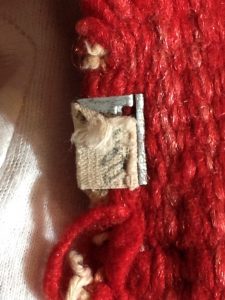As part of Mark and Linda Winter’s consultant visit, we viewed the Luther Bean Museum’s (LBM) collection of Rio Grande textiles. I was particularly interested in the approximate periods, the type of wool used, and the nature of the dyes. Most of the textiles appear to be from the period of about 1870 to 1890. Wools included pure churro, merino-mix, and merino-contaminated churro. One may include mohair. The variety in the handspun wool showed differences in spinning methods, skill, and wool. Two of the textiles had been felted, from washing in hot water with agitation; possibly this happened more recently, in a washing machine.

Rio Grande Blanket, Collection of the LBM
There is no way to tell where the Rio Grande blankets may have been woven from looking at them because similar weavings were done all up and down the Rio Grande, so we could not identify artisans or regions. Most of the textiles incorporated natural, undyed wool colors, while many of the wool dyes were likely aniline. Some showed fading and running. Early aniline dyes were quite fugitive, fading easily. And probably due to the lack of water in this region, some wool was not thoroughly washed after dying, which could result in running of the dyes.

Cleaning tag on textile, Collection of the LBM
Mark showed us where some textiles had been cut down from their original lengths. He showed us original and later knots in the warp ends. He also showed us that one piece had sprung warps. The warps were under too much tension and broke, springing back to where they no longer were under tension, leaving loose sections of weft. We even found a probable dry cleaners tag on one of the textiles.
Mark identified our best pieces, selecting each for different reasons: purity of the wool, weaving skill, technical difficulty and excellence of a design, attention to detail in seaming, and the original nature of a piece, including one that he described as “loom-fresh” or having little wear
